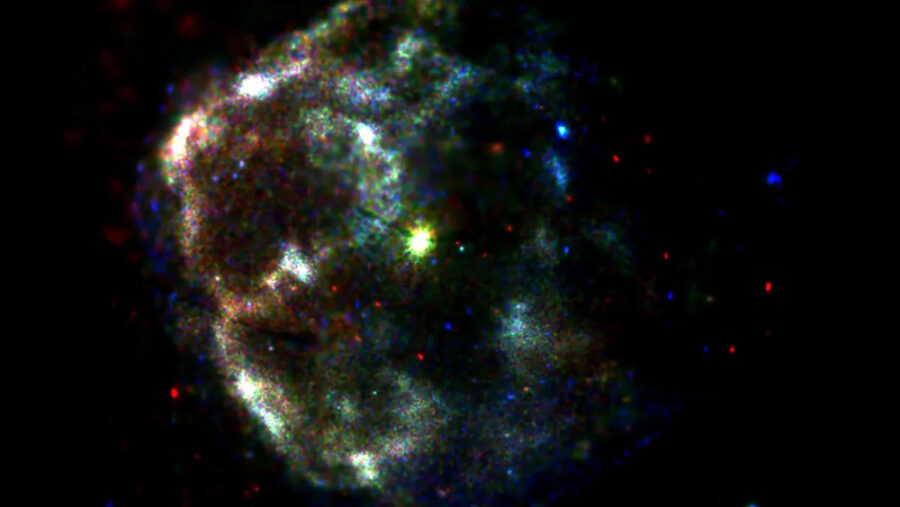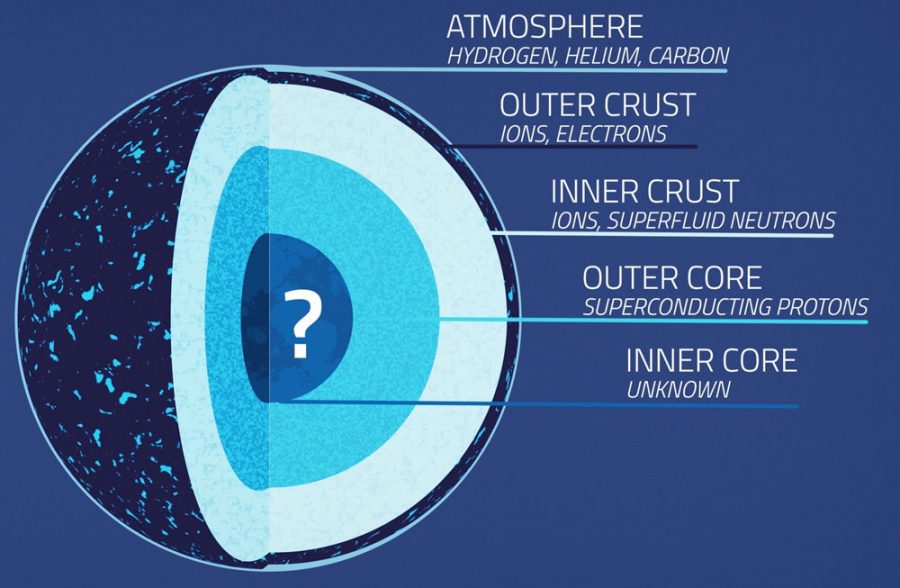
Victor Doroshenko and Gerd Pühlhofer / ESA / XMM-Newton / CC BY-SA 3.0 IGO
A team of astronomers claims to have measured the lightest neutron star, a finding that could entail new physics. But others say that such an extraordinary claim requires extraordinary evidence.
The object in question is a well-known neutron star at the heart of the supernova remnant HESS J1731–347, more than 8,000 light-years away in the constellation Scorpius. After re-analyzing X-ray observations taken over six years with the XMM-Newton and Suzaku space observatories, Victor Doroshenko and colleagues at the University of Tübingen, Germany, conclude in Nature Astronomy that this neutron star has only 80% of the Sun’s mass.
Neutron stars are not supposed to be this light. When an aging star loses its battle against gravity, its core collapses, crushing into a city-size sphere. This newborn neutron star is so dense that a single teaspoon brought to Earth would weigh 4 billion tons. Its formation triggers a shock wave that explodes the star’s outer layers into a gaseous cloud, but the collapsed core still ought to capture more than a Sun’s worth of mass.
“A 0.8-solar-mass neutron star is probably something which can cause discomfort for most people in the field,” acknowledges Doroshenko.
The evidence for a lightweight neutron star comes from constructing computer models of the heat emitted from a neutron star’s surface and atmosphere, and then matching those models to the X-ray spectra. To do this, the astronomers make some assumptions: They make the case that the neutron star radiates uniformly from its surface, heating a carbon-based atmosphere. (While the neutron star itself is composed of neutrons, it’s surrounded in an atmosphere just a couple inches thick that can contain whole nuclei.)
Based on these assumptions, Doroshenko’s team reproduce the X-ray observations using a lightweight model of a neutron star, with between 0.7 and 1 solar mass and a girth of some 10.4 kilometers (6.5 miles). If it is a neutron star, that mass and radius indicates a strange interior, one in which the neutrons break apart into their constituents — quarks — or transform into another exotic state of matter.

NASA’s Goddard Space Flight Center / Conceptual Image Lab
Previous observations of high-mass neutron stars (using the NICER X-ray telescope as well as gravitational wave signals) have indicated no such breakdown — “normal” matter all the way down. But as of yet, all the measurements have enough wiggle room that there are no direct contradictions.
There’s another intriguing possibility. The object could instead be a “strange star,” a star made entirely of quarks. But the physics of making a lightweight version of such a star is even more fraught than in the case of neutron stars.
Extraordinary Claims . . .
“This would be an amazing result if true,” says Cole Miller (University of Maryland), a neutron star expert not involved in the study. The discovery could lead to a new understanding of how neutron stars form, maybe even a new understanding of the physics of dense matter.
“As a result, the threshold for proof is extremely high,” he says. “This article does not meet that threshold.”
The problems, he says, comes back to the assumptions the team made in producing neutron star models. Perhaps there’s a magnetic field to consider, or maybe only a small part of the surface — such as its poles — radiates, or its atmosphere might be more hydrogen than carbon. If the team breaks any one of these assumptions, then the best-fitting model could have a larger mass.
“I do want to say that this type of work is certainly important,” Miller adds. “It's just that more i’s need to be dotted and t’s crossed to arrive firmly at such an exciting conclusion.”
Doroshenko emphasizes the need for additional observations in order to make more precise measurements. No doubt astronomers will return to revisit the mysterious object in this supernova remnant.
 3
3









Comments
Lou
October 26, 2022 at 10:16 am
On a related note, an article just published in The Astrophysical Journal Letters suggests phase-transitions are dissolving neutrons into sea of quarks; the density of such objects could be found via "peak spectral frequency” (f2) with next-generation Gravitational Wave observatories.
You must be logged in to post a comment.
robert stenton
October 31, 2022 at 7:40 pm
Weight depends on a gravitational field. If teaspoon of a neutron star would weigh 4 billion tons on earth, it must weigh considerable more on the neutron star. What is that amount?
You must be logged in to post a comment.
Monica YoungPost Author
November 15, 2022 at 1:42 pm
Good question! In this case, the weight corresponds to the mass, because tons are a metric measurement of mass (1 ton = 1,000 kg). The reason I brought the teaspoon to Earth in the analogy was so that I could use the word "weigh." Clearly, things would be simpler if we all agreed to use metric! 🙂
You must be logged in to post a comment.
You must be logged in to post a comment.